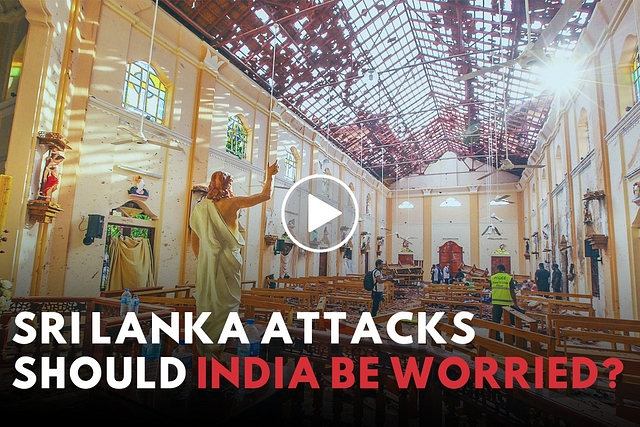
Sri Lanka Attacks: What We Know And Why It Should Worry India
Transcript:
On Easter Sunday, as Christians in Sri Lanka gathered at their local church for special services, terror reared its ghastly head, claiming the lives of over 250 people and injuring hundreds.
The targets were churches and hotels. There were six blasts in all. Three at churches - in the capital, Colombo; in Negombo, to the north; and in Batticaloa to the east, while the Shangri-La, Kingsbury, and Cinnamon Grand hotels in Colombo were the site of the other three blasts.
There were a couple more explosions later, with the police trying to defuse bombs even till the next day. But soon, things were brought under control.
It wouldn’t have been easy for the locals to imagine such a thing happening to them because it had been a decade since they had seen battle and bloodshed on such a scale. Before the days of 2009, Sri Lanka was the stage for a conflict between the Sinhalese and the Tamil ethnic group. But since then, there had been relative peace. Until the Easter Sunday.
The victims of the bombings were mostly locals. However, close to 40 foreign nationals were among the dead, including citizens from the US, UK, and India.
After the blasts, Sri Lanka was quick to chase down suspects. The movement was swift, and many were rounded up within hours. After further investigation, they identified nine suicide bombers - eight had blown themselves up at or near hotels or churches, and one woman had done so at a private home.
Among them, three or four bombers draw significant interest - for who they are, where they come from, and other background information - especially from the point of view of Indian security.
Chief among the attackers was Zahran Hashim, a native of Kattankudy near Batticaloa. Hashim blew himself up in Colombo. He is a Tamil-speaking Islamist preacher known to have founded the group National Thowheed Jamath. An Islamic State video claiming responsibility for the attacks features Hashim, where he is seen pledging allegiance to Islamic State leader Abu Bakr al-Baghdadi.
What’s concerning is that the Sri Lankan National Thowheed Jamath may have links to India’s Tamil Nadu Thowheed Jamath, though the latter has indicated that there are none. In fact, credible reports have emerged that say TNTJ’s chief ideologue, Moulvi P Jainul Abdeen, is considered an influential figure in the Sri Lankan Islamic terror network. He along with Kovai Ayub of Coimbatore have come to be seen as inspiration for the Sri Lankan suicide bombers.
Hashim’s partner in crime, bombing the Shangri-La hotel, was Ilham Ahmed Ibrahim. His brother, Imsath Ahmed Ibrahim, bombed the Cinnamon Grand hotel in Colombo. The brothers were reportedly at the centre of Islamist groups that sent at least 36 people to fight with Islamic State in Syria.
Curiously, it emerged that the Ibramin brothers are sons of Alhaj Mohammed Yusuf Ibrahim, a wealthy and renowned spice trader in Sri Lanka. This speaks to how radicalisation cuts across the economic spectrum. Even the Sri Lankan authorities confirmed this by saying most of the attackers were “educated” and belonged to “middle or upper middle class” families.
And then, there was Mohammed Hashtoon, whose attack was the deadliest, at the church of St Sebastian. The family connection here is even more worrying. Because his wife, who is considered to have had an active role in the terror plot, was a Tamil Hindu converted to Islam. Sri Lankan authorities are currently investigating whether the wife intended to be a bomber herself after a pastor of a church identified her as wearing a long skirt and waiting at the gates of his church at daybreak Easter morning.
According to a media investigation based on an interview with her mother, Pulasthini Mahendran, born in a devout lower middle class Hindu family in Sri Lanka’s Thettativu, was abducted and radicalised by functionaries of Islamist groups. Before she was taken away, Pulasthini was a medical student.
Going into the backgrounds of the suicide bombers leads us to the harsh reality that the India connection is undeniable and a serious cause for concern. In fact, India knew about these terrorists well before the blasts because of their connection with Tamil Nadu. We’ve made a video on it as well - you can click here to watch it.
The fact that the Indian intelligence has been able to stay ahead of impending terror plots is reassuring. The NIA has been able to prevent any attack from happening on Tamil Nadu soil since the fateful blasts in Coimbatore in 1998. However, recent events suggest that the stakes are high and connections deep. Islamic State has even claimed a “province” in Kashmir, though that might possibly be hot air. In any case, India should not let their guard down - or there would be much to lose.
Keep watching our videos. We have much to create and share with you. Do like, share, and subscribe! We are grateful for your support.
*
Watch: Behind India’s Warning To Sri Lanka: How India Knew About The Terror Plot
*
Subscribe to Swarajya on YouTube to keep up with our regular stream of videos.